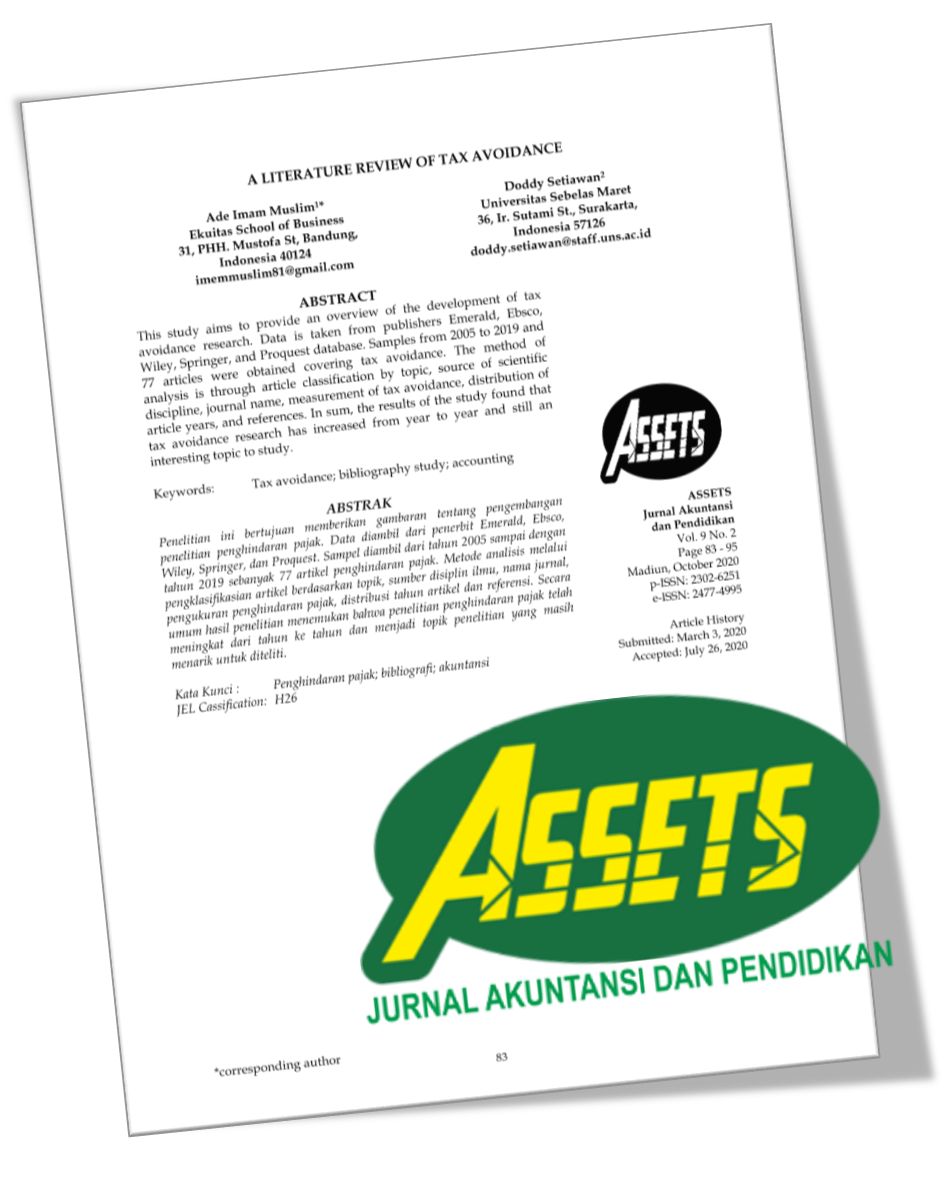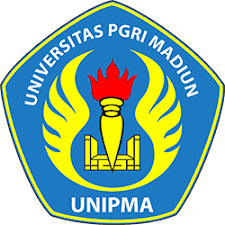MODEL ADOPTION BLENDED LEARNING: A STUDENT-CENTRIC EVALUATION IN ACCOUNTING EDUCATION
Abstract
ABSTRACT
This study aims to develop a conceptual model of the behavioral interest of accounting students in adopting blended learning by combining the technology acceptance model and the theory of planned behavior, along with validating explanatory variables such as perceived usefulness, perceived ease of use, learning attitudes, subjective norms, and behavioral control. The study sample consists of accounting students in Semarang, with structural equation modeling used as the analytical tool. It was found that perceived ease and behavioral control did not impact learning attitudes, while perceived usefulness and subjective norms also showed no effect. The intention to adopt blended learning is influenced by perceived ease, learning attitudes, subjective norms, and behavioral control but not by perceived usefulness. Learning attitudes serve as a mediator between the effects of perceived ease and behavioral control on students' intention to adopt blended learning.
ABSTRAK
Penelitian ini bertujuan untuk mengembangkan model konseptual terkait minat mahasiswa akuntansi dalam mengadopsi blended learning dengan menggabungkan model penerimaan teknologi dan teori perilaku terencana. Penelitian ini juga berusaha memvalidasi variabel-variabel penjelas seperti persepsi manfaat, persepsi kemudahan, sikap belajar, norma subjektif, dan kontrol perilaku. Sampel yang digunakan adalah mahasiswa akuntansi di Kota Semarang, dengan menggunakan model persamaan struktural sebagai alat analisis. Hasil penelitian menunjukkan bahwa persepsi kemudahan dan kontrol perilaku berpengaruh terhadap sikap belajar, sementara persepsi manfaat dan norma subjektif tidak memiliki pengaruh. Minat dalam mengadopsi blended learning dipengaruhi oleh persepsi kemudahan, sikap belajar, norma subjektif, dan kontrol perilaku, kecuali persepsi manfaat. Sikap belajar berperan sebagai mediator dalam hubungan antara persepsi kemudahan dan kontrol perilaku dengan minat mahasiswa untuk mengadopsi blended learning.
Keywords
Full Text:
PDFReferences
Ajzen, I. (1991). The Theory of Planned Behavior. Organizational Behavior and Human Decision Processes, 50 (1), 179–211. https://doi.org/10.47985/dcidj.475
Al-Azawei, A., Parslow, P., & Lundqvist, K. (2017). Investigating the effect of learning styles in a blended e-learning system: An extension of the technology acceptance model (TAM). Australasian Journal of Educational Technology, 33(2), 1–23. https://doi.org/10.14742/ajet.2741
Amenduni, F., Annese, S., Candido, V., McLay, K., & Ligorio, M. B. (2021). Blending Academic and Professional Learning in a University Course for Future E-learning Specialists: The Perspective of Company Tutors. Education Sciences, 11(8), 1–15. https://doi.org/10.3390/educsci11080415
Andiola, L. M., Masters, E., & Norman, C. (2020). Integrating technology and data analytic skills into the accounting curriculum: Accounting department leaders’ experiences and insights. Journal of Accounting Education, 50(1), 1–18. https://doi.org/10.1016/j.jaccedu.2020.100655
Anthony, B., Kamaludin, A., Romli, A., Raffei, A. F. M., Phon, D. N. A. L. E., Abdullah, A., & Ming, G. L. (2022). Blended Learning Adoption and Implementation in Higher Education: A Theoretical and Systematic Review. In Technology, Knowledge and Learning 27(2). https://doi.org/10.1007/s10758-020-09477-z
Anthony Jnr, B., Kamaludin, A., Romli, A., Mat Raffei, A. F., A_L Eh Phon, D. N., Abdullah, A., Leong Ming, G., A Shukor, N., Shukri Nordin, M., & Baba, S. (2020). Predictors of blended learning deployment in institutions of higher learning: theory of planned behavior perspective. International Journal of Information and Learning Technology, 37(4), 179–196. https://doi.org/10.1108/IJILT-02-2020-0013
Ashraf, M. A., Shabnam, N., Tsegay, S. M., & Huang, G. (2023). Acceptance of Smart Technologies in Blended Learning: Perspectives of Chinese Medical Students. International Journal of Environmental Research and Public Health, 20(3), 1–14. https://doi.org/10.3390/ijerph20032756
Azizi, S. M., Roozbahani, N., & Khatony, A. (2020). Factors affecting the acceptance of blended learning in medical education: application of UTAUT2 model. BMC Medical Education, 20(1), 1–9. https://doi.org/10.1186/s12909-020-02302-2
Cao, W. (2023). A meta-analysis of effects of blended learning on performance, attitude, achievement, and engagement across different countries. Frontiers in Psychology, 14(1), 1–15. https://doi.org/10.3389/fpsyg.2023.1212056
Cheng, E. W. L. (2019). Choosing between the theory of planned behavior (TPB) and the technology acceptance model (TAM). Educational Technology Research and Development, 67(1), 21–37. https://doi.org/10.1007/s11423-018-9598-6
Chu, T. H., & Chen, Y. Y. (2016). With Good We Become Good: Understanding e-learning adoption by theory of planned behavior and group influences. Computers and Education, 93(1), 37–52. https://doi.org/10.1016/j.compedu.2015.09.013
Davis, F. D., Bagozzi, R. P., & Warshaw, P. R. (1989). User Acceptance of Computer Technology: A Comparison of Two Theoretical Models. Management Science, 35(8), 982–1003. https://doi.org/10.1287/mnsc.35.8.982
Dziuban, C., Graham, C. R., Moskal, P. D., Norberg, A., & Sicilia, N. (2018). Blended learning: the new normal and emerging technologies. International Journal of Educational Technology in Higher Education, 15(3), 1-16. https://doi.org/10.1186/s41239-017-0087-5
Fadhilatunisa, D., Fakhri, M. M., & Rosidah, R. (2020). Pengaruh Blended Learning Terhadap Aktivitas Belajar Dan Hasil Belajar Mahasiswa Akuntansi. Jurnal Pendidikan Akuntansi Indonesia, 18(2), 93–106. https://doi.org/10.21831/jpai.v18i2.35345
Fatah, K. (2022). Factors Affecting Acceptance of the Use of Open Learning with the Theory of Planned Behavior ( TPB ) Approach to Accounting Students at Muhammadiyah University of Pekajangan Pekalongan. The 15th University Research Colloqium 2022 Universitas Muhammadiyah Gombong Factors, 1–10.
Hair, J. F., Risher, J. J., Sarstedt, M., & Ringle, C. M. (2019). When to use and how to report the results of PLS-SEM. European Business Review, 31(1), 2–24. https://doi.org/10.1108/EBR-11-2018-0203
Hasanah, Hasanah; Muh, Nasir., & Malik. (2020). Blended learning in improving students’ critical thinking and communication skills at Universit. Cypriot Journal of Educational Sciences, 15(5), 1295–1306. https://doi.org/https://doi.org/10.18844/cjes.v15i5.5168
Helsa, Y., Marasabessy, R., Juandi, D., & Turmudi, T. (2022). Penerapan Hybrid Learning di Perguruan Tinggi Indonesia: Literatur Review. Jurnal Cendekia : Jurnal Pendidikan Matematika, 7(1), 139–162. https://doi.org/10.31004/cendekia.v7i1.1910
Keržič, D., Tomaževič, N., Aristovnik, A., & Umek, L. (2019). Exploring critical factors of the perceived usefulness of blended learning for higher education students. PLoS ONE, 14(11), 1–18. https://doi.org/10.1371/journal.pone.0223767
Kurniawan, R., Pramana, E., & Budianto, H. (2021). The Adoption of Blended Learning in Non-Formal Education Using Extended Technology Acceptance Model. Indonesian Journal of Information Systems, 4(1), 27–42. https://doi.org/10.24002/ijis.v4i1.4415
Lachowicz, M. J., Preacher, K. J., & Kelley, K. (2018). A novel measure of effect size for mediation analysis. Psychological Methods, 23(2), 244–261. https://doi.org/10.1037/met0000165
Lazar, I. M., Panisoara, G., & Panisoara, I. O. (2020). Digital technology adoption scale in the blended learning context in higher education: Development, validation and testing of a specific tool. PLoS ONE, 15(7), 1–27. https://doi.org/10.1371/journal.pone.0235957
Lifatin, S., Rochman, E., & Alwan Sri, K. (2019). Analisis Penerimaan Penggunaan E-Learning dengan Pendekatan Theory of Planned Behavior (TPB) pada Mahasiswa Akuntansi Universitas Jember. E-Journal Ekonomi Bisnis Dan Akuntansi, 6(1), 120–126. https://doi.org/10.19184/ejeba.v6i2.11151
Medina, L. C. (2018). Blended learning : Deficits and prospects in higher education. Australasian Journal of Educational Technology, 34(1), 42–56. https://doi.org/10.14742/ajet.3100
Mihartinah, D., & Coryanata, I. (2019). Pengaruh Sikap Terhadap Perilaku, Norma Subjektif, Dan Kontrol Perilaku Persepsian Terhadap Niat Mahasiswa Akuntansi Untuk Mengambil Sertifikasi Chartered Accountant. Jurnal Akuntansi, 8(2), 77–88. https://doi.org/10.33369/j.akuntansi.8.2.77-88
Mouloudj, K., Bouarar, A. C., & Stojczew, K. (2021). Analyzing the Students’ Intention to Use Online Learning System in the Context of COVID-19 Pandemic: A Theory of Planned Behavior Approach. Advances in Global Education and Research, 4, 1–17. https://doi.org/10.5038/9781955833042
Muslim, E. B., Yuniawan, R., & Virgiawan, R. (2021). FAKTOR-FAKTOR YANG MEMPENGARUHI INTENTION TO USE VIRTUAL LEARNING (Studi Kasus Mahasiswa Ekonomi Islam FIAI UII). Jurnal Mahasiswa FIAI-UII, at-Thullab, 2(2), 418–427. http://doi.org/10.1186/s41239-017-0066-x
Mustafa, M. H., Ahmad, M. B., Shaari, Z. H., & Jannat, T. (2021). Integration of TAM, TPB, and TSR in understanding library user behavioral utilization intention of physical vs. E-book format. Journal of Academic Librarianship, 47(5), 1-11. https://doi.org/10.1016/j.acalib.2021.102399
Nikolopoulou, K., & Zacharis, G. (2023). Blended Learning in a Higher Education Context: Exploring University Students’ Learning Behavior. Education Sciences, 13(1), 1-14. https://doi.org/10.3390/educsci13050514
Ogbeibu, S., Chiappetta Jabbour, C. J., Burgess, J., Gaskin, J., & Renwick, D. W. S. (2022). Green talent management and turnover intention: the roles of leader STARA competence and digital task interdependence. Journal of Intellectual Capital, 23(1), 27–55. https://doi.org/10.1108/JIC-01-2021-0016
Platonova, R. I., Orekhovskaya, N. A., Dautova, S. B., Martynenko, E. V, Kryukova, N. I., & Demir, S. (2022). Blended Learning in Higher Education: Diversifying Models and Practical Recommendations for Researchers. Frontiers in Education, 7(1), 1-11. https://www.frontiersin.org/articles/10.3389/feduc.2022.957199
Rajeh, M. T., Abduljabbar, F. H., Alqahtani, S. M., Waly, F. J., Alnaami, I., Aljurayyan, A., & Alzaman, N. (2021). Students’ satisfaction and continued intention toward e-learning: a theory-based study. Medical Education Online, 26(1), 1-8. https://doi.org/10.1080/10872981.2021.1961348
Salloum, S. A., Qasim Mohammad Alhamad, A., Al-Emran, M., Abdel Monem, A., & Shaalan, K. (2019). Exploring students’ acceptance of e-learning through the development of a comprehensive technology acceptance model. IEEE Access, 7, 128445–128462. https://doi.org/10.1109/ACCESS.2019.2939467
Schenk, B., & Hoxhaj, L. (2019). Challenges in switching to blended learning environments: An analysis of students’ attitudes and performance. 40th International Conference on Information Systems, ICIS 2019.
Sholihin, M., & Ratmono, D. (2021). Analisis SEM-PLS dengan WarpPLS 7.0 : untuk hubungan nonlinier dalam penelitian sosial dan bisnis (C. Mitak (ed.); 1st ed.). Yogyakarta : Andi.
Siahaan, S. D. N., & Pramana, D. (2020). Strategi Pembelajaran Blended Learning Terhadap Motivasi, Hasil, Dan Mutu Belajar Mahasiswa. Ekuitas: Jurnal Pendidikan Ekonomi, 8(2), 97–109. https://doi.org/10.23887/ekuitas.v8i2.28435
Singh, J., Steele, K., & Singh, L. (2021). Combining the Best of Online and Face-to-Face Learning: Hybrid and Blended Learning Approach for COVID-19, Post Vaccine, & Post-Pandemic World. Journal of Educational Technology Systems, 50(2), 140–171. https://doi.org/10.1177/00472395211047865
Stamp, J., & Clemons, D. (2021). Application of The Theory of Planned Behavior to Generation Z and Higher Education. Journal of Student Research, 10(3), 1–10. https://doi.org/10.47611/jsr.v10i3.1294
Sugahara, S., & Cilloni, A. (2021). Mediation effect of students’ perception of accounting on the relationship between game-based learning and learning approaches. Journal of Accounting Education, 56(1), 1-17. https://doi.org/10.1016/j.jaccedu.2021.100730
Suhartono, E., & Pratiwi, A. N. (2023). Faktor-faktor yang Mempengaruhi Niat Mahasiswa Mengikuti Kuliah Akuntansi dengan E-learning: Pendekatan Theory of Planned Behavior. Jurnal Akuntansi, Keuangan Dan Auditing, 4(1), 300–315. http://publikasi.dinus.ac.id/index.php/jaka
Taghizadeh, M., & Hajhosseini, F. (2021). Investigating a Blended Learning Environment: Contribution of Attitude, Interaction, and Quality of Teaching to Satisfaction of Graduate Students of TEFL. Asia-Pacific Education Researcher, 30(5), 459–469. https://doi.org/10.1007/s40299-020-00531-z
Tran, T. T., & Herzig, C. (2023). Blended case-based learning in a sustainability accounting course: An analysis of student perspectives. Journal of Accounting Education, 63(1), 1-17. https://doi.org/10.1016/j.jaccedu.2023.100842
Ubaidillah, A. R., Setiadi, D., Yamin, M., & Artayasa, I. P. (2022). Analisis Hambatan Pelaksanaan Blended Learning Pada Pembelajaran Biologi di SMAN 1 Lingsar. Jurnal Ilmiah Profesi Pendidikan, 7(3b), 1633–1638. https://doi.org/10.29303/jipp.v7i3b.810
Um, N. (2021). Learners’ Attitude toward E-Learning: The Effects of Perceived System Quality and E-Learning Usefulness, Self-Management of Learning, and Self-Efficacy. International Journal of Contents, 17(2), 41–47. https://doi.org/10.5392/IJoC.2021.17.2.041
UNESCO. (2020). COVID-19 educational disruption and response. UNESCO.
Verpoorten, D., Huart, J., Detroz, P., & Jérôme, F. (2022). Blended Learning in Higher Education: Faculty Perspective through the Lens of the Planned Behaviour Theory. In M. M. C. Shohel (Ed.), IntechOpen : E-Learning and Digital Education in the Twenty-First Century (pp. 1–20). University of Liège. https://doi.org/10.5772/intechopen.95375
Virani, S. R., Saini, J. R., & Sharma, S. (2020). Adoption of massive open online courses (MOOCs) for blended learning: the Indian educators’ perspective. Interactive Learning Environments, 31(2), 1060–1076. https://doi.org/https://doi.org/10.1080/10494820.2020.1817760
Wahyuni, A. T., Yunisca, L., & Handican, R. (2023). Blended Learning: Bagaimana Persepsi Mahasiswa? Griya Journal of Mathematics Education and Application, 3(1), 125–134. https://doi.org/10.29303/griya.v3i1.281
Yao, Y., Wang, P., Jiang, Y. J., Li, Q., & Li, Y. (2022). Innovative online learning strategies for the successful construction of student self-awareness during the COVID-19 pandemic: Merging TAM with TPB. Journal of Innovation and Knowledge, 7(4), 1-9. https://doi.org/10.1016/j.jik.2022.100252
Yu, T., Dai, J., & Wang, C. (2023). Adoption of blended learning: Chinese university students’ perspectives. Humanities and Social Sciences Communications, 10(1), 1–16. https://doi.org/10.1057/s41599-023-01904-7
Yulita, H., & Hidajat, K. (2021). Pengaruh Adopsi Inovasi E-Learning terhadap Minat Belajar Mahasiswa Dimediasi Motivasi Belajar pada Era New Normal. Journal of Business & Applied Management, 14(1), 27–44. https://doi.org/10.30813/jbam.v14i1.2709
Zeqiri, J., Kareva, V., & Alija, S. (2021). Blended Learning and Student Satisfaction: The Moderating Effect of Student Performance. Business Systems Research, 12(2), 79–94. https://doi.org/10.2478/bsrj-2021-0020
Article Metrics
Abstract has been read : 31 timesPDF file viewed/downloaded: 0 times
DOI: http://doi.org/10.25273/jap.v13i2.19413
Refbacks
- There are currently no refbacks.
Copyright (c) 2024 Entot Suhartono & Purwantoro

This work is licensed under a Creative Commons Attribution-ShareAlike 4.0 International License.
ASSETS: Jurnal Akuntansi dan Pendidikan is supported by
ASSETS: Jurnal Akuntansi dan Pendidikan is indexed by
| | | ||||
| | | | |

ASSETS: Jurnal Akuntansi dan Pendidikan is licensed under a Creative Commons Attribution-ShareAlike 4.0 International License.











